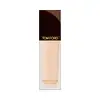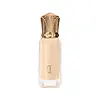Tom Ford Architecture Soft Matte Blurring Foundation Versus Christian Louboutin Teint Fétiche Le Fluide Liquid Foundation
What's inside
What's inside
 Key Ingredients
Key Ingredients

 Benefits
Benefits

 Concerns
Concerns

 Ingredients Side-by-side
Ingredients Side-by-side

Methyl Trimethicone
Skin ConditioningWater
Skin ConditioningTrimethylsiloxysilicate
EmollientDimethicone
EmollientSilica
AbrasivePEG-10 Dimethicone
Skin ConditioningButylene Glycol
HumectantPEG/PPG-18/18 Dimethicone
EmulsifyingHexyldecanol
EmollientLaminaria Saccharina Extract
Skin ProtectingLavandula Hybrida Oil
EmollientGlycine Soja Protein
EmulsifyingLavandula Angustifolia Oil
MaskingSilybum Marianum Fruit Extract
Skin ConditioningSigesbeckia Orientalis Extract
Skin ConditioningTocopherol
AntioxidantSodium Hyaluronate
HumectantTrehalose
HumectantCaprylyl Glycol
EmollientGlycerin
HumectantCaffeine
Skin ConditioningCholesterol
EmollientAcetyl Hexapeptide-8
HumectantDimethicone/Vinyl Dimethicone Crosspolymer
Skin ConditioningMethicone
EmollientMagnesium Aluminum Silicate
AbsorbentDisteardimonium Hectorite
StabilisingCalcium Chloride
AstringentSodium Chloride
MaskingXanthan Gum
EmulsifyingVinyl Dimethicone/Methicone Silsesquioxane Crosspolymer
Lecithin
EmollientLinalool
PerfumingLinalyl Acetate
MaskingTetrahexyldecyl Ascorbate
AntioxidantTocopheryl Acetate
AntioxidantBHT
AntioxidantDisodium EDTA
Phenoxyethanol
PreservativePotassium Sorbate
PreservativeMica
Cosmetic ColorantCI 77891
Cosmetic ColorantCI 77491
Cosmetic ColorantCI 77492
Cosmetic ColorantCI 77499
Cosmetic ColorantMethyl Trimethicone, Water, Trimethylsiloxysilicate, Dimethicone, Silica, PEG-10 Dimethicone, Butylene Glycol, PEG/PPG-18/18 Dimethicone, Hexyldecanol, Laminaria Saccharina Extract, Lavandula Hybrida Oil, Glycine Soja Protein, Lavandula Angustifolia Oil, Silybum Marianum Fruit Extract, Sigesbeckia Orientalis Extract, Tocopherol, Sodium Hyaluronate, Trehalose, Caprylyl Glycol, Glycerin, Caffeine, Cholesterol, Acetyl Hexapeptide-8, Dimethicone/Vinyl Dimethicone Crosspolymer, Methicone, Magnesium Aluminum Silicate, Disteardimonium Hectorite, Calcium Chloride, Sodium Chloride, Xanthan Gum, Vinyl Dimethicone/Methicone Silsesquioxane Crosspolymer, Lecithin, Linalool, Linalyl Acetate, Tetrahexyldecyl Ascorbate, Tocopheryl Acetate, BHT, Disodium EDTA, Phenoxyethanol, Potassium Sorbate, Mica, CI 77891, CI 77491, CI 77492, CI 77499
Isododecane
EmollientWater
Skin ConditioningDimethicone
EmollientPropanediol
SolventTrimethylsiloxysilicate
EmollientGlycerin
HumectantPEG-10 Dimethicone
Skin ConditioningSilica
AbrasivePEG/PPG-18/18 Dimethicone
EmulsifyingDisteardimonium Hectorite
StabilisingPolysilicone-11
Sodium Chloride
MaskingPhenoxyethanol
PreservativePropylene Carbonate
SolventCaprylyl Glycol
EmollientCentella Asiatica Leaf Extract
Skin ConditioningAluminum Hydroxide
EmollientParfum
MaskingTriethoxycaprylylsilane
Ceramide NP
Skin ConditioningAmethyst Powder
AbrasiveSodium Hyaluronate
HumectantCaprylic/Capric Triglyceride
MaskingDecyl Glucoside
CleansingHexylene Glycol
EmulsifyingUndaria Pinnatifida Extract
Skin ConditioningLinalool
PerfumingCitronellol
PerfumingGeraniol
PerfumingAlpha-Isomethyl Ionone
PerfumingBenzyl Salicylate
PerfumingCitral
PerfumingCI 77891
Cosmetic ColorantCI 77491
Cosmetic ColorantCI 77492
Cosmetic ColorantCI 77499
Cosmetic ColorantIsododecane, Water, Dimethicone, Propanediol, Trimethylsiloxysilicate, Glycerin, PEG-10 Dimethicone, Silica, PEG/PPG-18/18 Dimethicone, Disteardimonium Hectorite, Polysilicone-11, Sodium Chloride, Phenoxyethanol, Propylene Carbonate, Caprylyl Glycol, Centella Asiatica Leaf Extract, Aluminum Hydroxide, Parfum, Triethoxycaprylylsilane, Ceramide NP, Amethyst Powder, Sodium Hyaluronate, Caprylic/Capric Triglyceride, Decyl Glucoside, Hexylene Glycol, Undaria Pinnatifida Extract, Linalool, Citronellol, Geraniol, Alpha-Isomethyl Ionone, Benzyl Salicylate, Citral, CI 77891, CI 77491, CI 77492, CI 77499
Ingredients Explained
These ingredients are found in both products.
Ingredients higher up in an ingredient list are typically present in a larger amount.
Caprylyl Glycol is a humectant and emollient, meaning it attracts and preserves moisture.
It is a common ingredient in many products, especially those designed to hydrate skin. The primary benefits are retaining moisture, skin softening, and promoting a healthy skin barrier.
Though Caprylyl Glycol is an alcohol derived from fatty acids, it is not the kind that can dry out skin.
This ingredient is also used as a preservative to extend the life of products. It has slight antimicrobial properties.
Learn more about Caprylyl GlycolCi 77491 is also hydrated iron III oxide. It's sole purpose is to give a red/pink hue to products.
Iron III oxides are classified as inorganic chemicals for coloring.
Synthetically created Ci 77491 is considered safer than those naturally found. This is because the synthetically created version may contain less impurities. Iron oxides are generally non-toxic and non-allergenic.
Learn more about CI 77491Ci 77492 is also hydrated iron III oxide. It's sole purpose is to give a yellow hue to products.
Iron III oxides are classified as inorganic chemicals for coloring.
Synthetically created Ci 77492 is considered safer than those naturally found. This is because the synthetically created version may contain less impurities. Iron oxides are generally non-toxic and non-allergenic.
Learn more about CI 77492Ci 77499 is also hydrated iron III oxide. It is created from mixing red and black iron oxides. This helps give shades of darkness to a product.
Iron III oxides are classified as inorganic chemicals for coloring.
Ci 77891 is a white pigment from Titanium dioxide. It is naturally found in minerals such as rutile and ilmenite.
It's main function is to add a white color to cosmetics. It can also be mixed with other colors to create different shades.
Ci 77891 is commonly found in sunscreens due to its ability to block UV rays.
Learn more about CI 77891Dimethicone is a type of synthetic silicone created from natural materials such as quartz.
What it does:
Dimethicone comes in different viscosities:
Depending on the viscosity, dimethicone has different properties.
Ingredients lists don't always show which type is used, so we recommend reaching out to the brand if you have questions about the viscosity.
This ingredient is unlikely to cause irritation because it does not get absorbed into skin. However, people with silicone allergies should be careful about using this ingredient.
Note: Dimethicone may contribute to pilling. This is because it is not oil or water soluble, so pilling may occur when layered with products. When mixed with heavy oils in a formula, the outcome is also quite greasy.
Learn more about DimethiconeDisteardimonium Hectorite comes from the clay mineral named hectorite. It is used to add thickness to a product.
It can also help stabilize a product by helping to disperse other ingredients.
Hectorite is a rare, white clay mineral.
Learn more about Disteardimonium HectoriteGlycerin is already naturally found in your skin. It helps moisturize and protect your skin.
A study from 2016 found glycerin to be more effective as a humectant than AHAs and hyaluronic acid.
As a humectant, it helps the skin stay hydrated by pulling moisture to your skin. The low molecular weight of glycerin allows it to pull moisture into the deeper layers of your skin.
Hydrated skin improves your skin barrier; Your skin barrier helps protect against irritants and bacteria.
Glycerin has also been found to have antimicrobial and antiviral properties. Due to these properties, glycerin is often used in wound and burn treatments.
In cosmetics, glycerin is usually derived from plants such as soybean or palm. However, it can also be sourced from animals, such as tallow or animal fat.
This ingredient is organic, colorless, odorless, and non-toxic.
Glycerin is the name for this ingredient in American English. British English uses Glycerol/Glycerine.
Learn more about GlycerinLinalool is a fragrance and helps add scent to products. It's derived from common plants such as cinnamon, mint, citrus, and lavender.
Like Limonene, this ingredient oxidizes when exposed to air. Oxidized linalool can cause allergies and skin sensitivity.
This ingredient has a scent that is floral, spicy tropical, and citrus-like.
Learn more about LinaloolPeg-10 Dimethicone is silicone with conditioner and emulsifier properties. It mostly acts as an emollient in skincare and and humectant in haircare.
According to the manufacturer, acidic formulations decrease the stability of this ingredient. It works best in neutral or near neutral formulations.
PEG/PPG-18/18 Dimethicone is a type of silicone.
Phenoxyethanol is a preservative that has germicide, antimicrobial, and aromatic properties. Studies show that phenoxyethanol can prevent microbial growth. By itself, it has a scent that is similar to that of a rose.
It's often used in formulations along with Caprylyl Glycol to preserve the shelf life of products.
Silica, also known as silicon dioxide, is a naturally occurring mineral. It is used as a fine, spherical, and porous powder in cosmetics.
Though it has exfoliant properties, the function of silica varies depending on the product.
The unique structure of silica enhances the spreadability and adds smoothness, making it a great texture enhancer.
It is also used as an active carrier, emulsifier, and mattifier due to its ability to absorb excess oil.
In some products, tiny microneedles called spicules are made from silica or hydrolyzed sponge. When you rub them in, they lightly polish away dead skin layers and enhance the penetration of active ingredients.
Learn more about SilicaChances are, you eat sodium chloride every day. Sodium Chloride is also known as table salt.
This ingredient has many purposes in skincare: thickener, emulsifier, and exfoliator.
You'll most likely find this ingredient in cleansers where it is used to create a gel-like texture. As an emulsifier, it also prevents ingredients from separating.
There is much debate on whether this ingredient is comedogenic. The short answer - comedogenic ratings don't tell the whole story. Learn more about comegodenic ratings here.
The concensus about this ingredient causing acne seems to be divided. Research is needed to understand if this ingredient does cause acne.
Scrubs may use salt as the primary exfoliating ingredient.
Learn more about Sodium ChlorideSodium Hyaluronate is hyaluronic acid's salt form. It is commonly derived from the sodium salt of hyaluronic acid.
Like hyaluronic acid, it is great at holding water and acts as a humectant. This makes it a great skin hydrating ingredient.
Sodium Hyaluronate is naturally occurring in our bodies and is mostly found in eye fluid and joints.
These are some other common types of Hyaluronic Acid:
Learn more about Sodium HyaluronateThis silicone is an emollient. Emollients create a thin film on the skin to prevent moisture from escaping.
It is not soluble in water and helps increase water-resistance in products.
According to a manufacturer, it can blend seamlessly with silicone oils, such as Cyclopentasiloxane.
Learn more about TrimethylsiloxysilicateWater. It's the most common cosmetic ingredient of all. You'll usually see it at the top of ingredient lists, meaning that it makes up the largest part of the product.
So why is it so popular? Water most often acts as a solvent - this means that it helps dissolve other ingredients into the formulation.
You'll also recognize water as that liquid we all need to stay alive. If you see this, drink a glass of water. Stay hydrated!
Learn more about Water